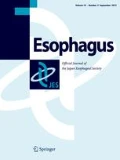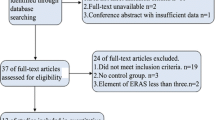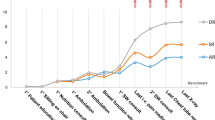Abstract
Enhanced recovery after surgery (ERAS) protocols vs standard care pathways after esophagectomy for malignancy have gained wide popularity among surgeons. However, the current literature is still lacking level-I evidence to show a clear superiority of one approach. The present study is a detailed systematic review and meta-analysis of the published trials. A systematic review of literature databases was conducted for randomized controlled trials (RCTs) and non-randomized, prospective, comparative studies between January 1990 and September 2019, comparing ERAS pathway group with standard care for esophageal resection for esophageal cancer. Mean difference (MD) for continuous variables and odds ratio (OR) or risk difference (RD) for dichotomous variables with 95% confidence interval (CI) were used. Between-study heterogeneity was evaluated. Eight studies with a total of 1133 patients were included. Hospital stay [Standard mean difference (Std. MD) = − 1.92, 95% CI − 2.78, − 1.06, P < 0.0001], overall morbidity (OR 0.68, CI 0.49, 0.96, P = 0.03), pulmonary complications (OR 0.45, CI 0.31, 0.65, P < 0.0001), anastomotic leak rate (OR 0.37, CI 0.18, 0.74, P = 0.005), time to first flatus and defecation (Std. MD = -5.01, CI − 9.53, − 0.49, P = 0.03), (Std. MD = − 1.36, CI − 1.78, − 0.94, P < 0.00001) and total hospital cost (Std. MD = − 1.62, CI − 2.24, − 1.01, P < 0.00001) favored the ERAS group. Patients who undergo ERAS have a clear benefit over the standard care protocol. However, existing protocols in different centers are followed by great variability, while the evaluated parameters suffer from significant heterogeneity. A well-formulated, standardized protocol should be standard-of-care at all centers.







Similar content being viewed by others
References
Yamamoto M, Weber JM, Karl RC, Meredith KL. Minimally invasive surgery for esophageal cancer: review of the literature and institutional experience. Cancer Control J Moffitt Cancer Cent. 2013;20(2):130–7.
Luketich JD, Pennathur A, Franchetti Y, et al. Minimally invasive esophagectomy: results of a prospective phase II multicenter trial-the eastern cooperative oncology group (E2202) study. Ann Surg. 2015;261(4):702–7.
Seesing MFJ, Gisbertz SS, Goense L, et al. A propensity score matched analysis of open versus minimally invasive transthoracic esophagectomy in the Netherlands. Ann Surg. 2017;266(5):839–46.
Kehlet H, Wilmore DW. Evidence-based surgical care and the evolution of fast-track surgery. Ann Surg. 2008;248(2):189–98.
Gustafsson UO, Scott MJ, Schwenk W, et al. Guidelines for perioperative care in elective colonic surgery: Enhanced Recovery After Surgery (ERAS(®)) Society recommendations. World J Surg. 2013;37(2):259–84.
Nygren J, Thacker J, Carli F, et al. Guidelines for perioperative care in elective rectal/pelvic surgery: enhanced recovery after surgery (ERAS(®)) society recommendations. World J Surg. 2013;37(2):285–305.
Glaser G, Dowdy SC, Peedicayil A. Enhanced recovery after surgery in gynecologic oncology. Int J Gynaecol Obstet Off Organ Int Fed Gynaecol Obstet. 2018;143(Suppl 2):143–6.
Lassen K, Coolsen MME, Slim K, et al. Guidelines for perioperative care for pancreaticoduodenectomy: enhanced recovery after surgery (ERAS®) society recommendations. Clin Nutr Edinb Scotl. 2012;31(6):817–30.
Cerfolio RJ, Bryant AS, Bass CS, et al. Fast tracking after Ivor Lewis esophagogastrectomy. Chest. 2004;126(4):1187–94.
Zhao G, Cao S, Cui J. Fast-track surgery improves postoperative clinical recovery and reduces postoperative insulin resistance after esophagectomy for esophageal cancer. Support Care Cancer Off J Multinatl Assoc Support Care Cancer. 2014;22(2):351–8.
Lee L, Li C, Robert N, Latimer E, et al. Economic impact of an enhanced recovery pathway for oesophagectomy. Br J Surg. 2013;100(10):1326–34.
Markar SR, Karthikesalingam A, Low DE. Enhanced recovery pathways lead to an improvement in postoperative outcomes following esophagectomy: systematic review and pooled analysis. Dis Esophagus Off J Int Soc Dis Esophagus. 2015;28(5):468–75.
Markar SR, Naik R, Malietzis G, et al. Component analysis of enhanced recovery pathways for esophagectomy. Dis Esophagus Off J Int Soc Dis Esophagus. 2017;30(10):1–10.
Moher D, Liberati A, Tetzlaff J, Altman DG; PRISMA Group. Preferred reporting items for systematic reviews andmeta-analyses: the PRISMA statement. PLoS Med 2009;6:e1000097.
Higgins JP, Altman DG et al., Cochrane Bias Methods Group; Cochrane Statistical Methods Group. The Cochrane Collaboration’stool for assessing risk of bias in randomised trials. BMJ 2011;343:d5928.
Moher D, Cook DJ, Eastwood S, et al. Improving the quality of reports of meta-analyses of randomised controlled trials: the QUOROM statement. Quality of reporting of meta-analyses. Lancet. 1999;354(9193):1896–900.
Hozo SP, Djulbegovic B, Hozo I. Estimating the mean and variance from the median, range, and the size of a sample. BMC Med Res Methodol. 2005;20(5):13.
Slim K, Nini E, Forestier D, et al. Methodological index for non-randomized studies (minors): development and validation of a new instrument. ANZ J Surg. 2003;73(9):712–6.
Sterne JA, Hernán MA, Reeves BC et al. ROBINS-I: a tool for assessing risk of bias in non-randomised studies of interventions. BMJ 2016;355: i4919.
DerSimonian R, Laird N. Meta-analysis in clinical trials. ControllClin Trials. 1986;7:177–88.
Mantel N, Haenszel W. Statistical aspects of the analysis of data from retrospective studies of disease. J Natl Cancer Inst. 1959;22(4):719–48.
Review Manager (RevMan) [Computer program]. Version 5.3. Copenhagen: The Nordic Cochrane Centre, The Cochrane Collaboration, 2014.
Ford SJ, Adams D, Dudnikov S, et al. The implementation and effectiveness of an enhanced recovery programme after oesophago-gastrectomy: a prospective cohort study. Int J Surg Lond Engl. 2014;12(4):320–4.
Low DE, Alderson D, Cecconello I, et al. International consensus on standardization of data collection for complications associated with esophagectomy: esophagectomy complications consensus group (ECCG). Ann Surg. 2015;262(2):286–94.
Koyanagi K, Tachimori Y. Early oral nutrition plays an active role in enhanced recovery after minimally invasive esophagectomy. J Thorac Dis. 2017;9(10):3598–602.
Low DE, Allum W, De Manzoni G, et al. Guidelines for perioperative care in esophagectomy: enhanced recovery after surgery (ERAS®) society recommendations. World J Surg. 2019;43(2):299–330.
Liu K, Ji S, Xu Y, et al. Safety, feasibility, and effect of an enhanced nutritional support pathway including extended preoperative and home enteral nutrition in patients undergoing enhanced recovery after esophagectomy: a pilot randomized clinical trial. Dis Esophagus. 2019. https://doi.org/10.1093/dote/doz030.
Yost MT, Jolissaint JS, Fields AC, Fisichella PM. Enhanced recovery pathways for minimally invasive esophageal surgery. J Laparoendosc Adv Surg Tech A. 2018;28(5):496–500.
Pisarska M, Małczak P, Major P, et al. Enhanced recovery after surgery protocol in oesophageal cancer surgery: systematic review and meta-analysis. PLoS ONE. 2017;12(3):e0174382.
Yoshida N, Baba Y, Shigaki H, Harada K, Iwatsuki M, Kurashige J, et al. Preoperative nutritional assessment by controlling nutritional status (CONUT) is useful to estimate postoperative morbidity after esophagectomy for esophageal cancer. World J Surg. 2016;40(8):1910–7.
Schizas D, Kosmopoulos M, Giannopoulos S, Giannopoulos S, Kokkinidis DG, Karampetsou N, et al. Meta-analysis of risk factors and complications associated with atrial fibrillation after oesophagectomy. Br J Surg. 2019;106(5):534–47.
Blom RLGM, van Heijl M, Bemelman WA, et al. Initial experiences of an enhanced recovery protocol in esophageal surgery. World J Surg. 2013;37(10):2372–8.
Li C, Ferri LE, Mulder DS, Ncuti A et al. An enhanced recovery pathway decreases duration of stay after esophagectomy. Surgery. 2012;152(4):606–614. (discussion 614–616)
Author information
Authors and Affiliations
Contributions
TT and SS reviewed the literature, completed data collection and contributed in writing the manuscript. MO contributed in writing the manuscript and provided extensive editing and proofreading. DS reviewed the literature and collected the articles. DT reviewed the manuscript and contributed in interpretation and analysis of the data. SS performed the statistical analysis and provided writing assistance and proof reading of the article. SS provided administrative support. TT and SS provided supervision and conception, and are responsible of final approval and accountability for all aspects of work.
Corresponding author
Ethics declarations
Ethical Statement
Each individual listed as an author on this manuscript contributed substantially and in accordance with the guidelines of the International Committee of Medical Journal Editors.
Conflict of interest
The authors declare no conflict of interest.
Additional information
Publisher's Note
Springer Nature remains neutral with regard to jurisdictional claims in published maps and institutional affiliations.
Electronic supplementary material
Rights and permissions
About this article
Cite this article
Triantafyllou, T., Olson, M.T., Theodorou, D. et al. Enhanced recovery pathways vs standard care pathways in esophageal cancer surgery: systematic review and meta-analysis. Esophagus 17, 100–112 (2020). https://doi.org/10.1007/s10388-020-00718-9
Received:
Accepted:
Published:
Issue Date:
DOI: https://doi.org/10.1007/s10388-020-00718-9




